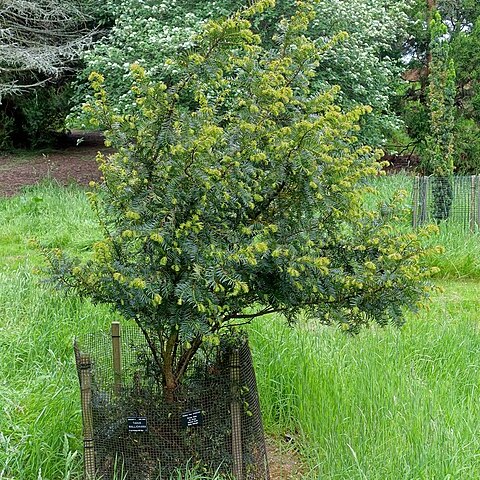Trees or shrubs to 30 m tall; trunk to 1.3 m d.b.h.; bark variably colored, grayish brownish, reddish, or purplish, peeling off in strips or cracking and falling off as thin scales; winter bud scales early deciduous or some persistent at base of branchlets, triangular-ovate, with or without longitudinal ridges abaxially. Leafy branchlets ± flat in living state, 3-9 × 1.5-6 cm in outline. Leaves borne at (50-)60-90° to branchlet axis, subsessile or with petiole to 1 mm; blade dark green and glossy adaxially, paler abaxially, linear to lanceolate, gradually tapered distally, usually falcate, (0.9-)1.5-3.5(-4.7) cm × (1.5-)2-4(-5) mm, midvein slightly elevated adaxially, 0.1-0.2 mm wide, densely and evenly papillate abaxially, or with papillae scattered on midvein or in 1-several lateral rows adjacent to stomatal band, or midvein not papillate, stomatal bands pale yellowish, 0.6-0.9 mm wide, densely and evenly papillate, marginal bands 0.1-0.4 mm wide, base cuneate or attenuate, asymmetric, margin flat to revolute, apex gradually acuminate or abruptly tapered and indistinctly mucronate, mucro 0.1-0.5 mm. Pollen cones scattered along 2nd year branchlet axis, ± sessile or shortly pedunculate (peduncle ca. 0.5 mm), pale yellowish, ovoid, 5-6 × ca. 3 mm; bracts usually 6, broadly ovate, pale green; microsporophylls 8-14, each with (4 or)5 or 6(-8) pollen sacs. Seed-bearing structures borne toward distal end of branchlet axis. Aril red or orange when ripe, often ± translucent. Seed ovoid or obovoid, occasionally columnar-oblong, sometimes slightly flattened, 5-8 × 3.5-5 mm, usually with obtuse ridges (sometimes trigonous and 3-ridged); apex with small mucro; hilum elliptic to suborbicular or rounded-trigonous. Pollination Sep-Apr, seed maturity Aug-Dec.
More
A tree. It grows 6-18 m tall. The branches are spreading. The bark is reddish-brown and scaly. The leaves are narrow and almost in spirals. They are 2-4 cm long. The female flowers are green and occur singly in the axils of leaves. The seed are olive green and surrounded by a red fleshy aril.
A small to large understorey or lower canopy tree in montane, temperate, warm temperate, and tropical submontane to high montane coniferous, broad-leaved and mixed forest; at elevations from 900-3,700 metres.
More
A small to large understorey or lower canopy tree in montane, temperate, warm temperate, and tropical submontane to high montane coniferous, broad-leaved and mixed forest; at elevations from 900-3,700 metres.
It is a temperate plant. In Northeastern India it grows between 2,400-3,200 m above sea level. Garhwal Himalayas


